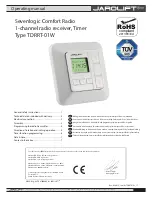
Synchronizing Multiple Radars
When multiple radars are co-located it may be necessary to synchronize their frequency
sweeps. If this functionality is desired, please order the radars with the “sync” option.
When ordered with this option, digital output 4 is utilized for SYNC purposes and is not
available as an open drain trigger output. The corresponding pins of the master and slave
radars must be connected together via an external harness for the master to send a sync
signal to the slave(s). Use a twisted pair (SYNC and Ground) to route synchronization
signal.
If a slave does not receive a sync signal from the master it will pause the measurements
and the green status LED on the side (or back depending on the build type) will not flash.
When sync signal is missing and the pause extends beyond 10-20s, the slave unit will be
automatically reset by a watchdog timer. The operation of the master unit is not affected.
Any unit may be configured as a master or a slave, but in a synchronized system, one and
only one unit must be configured as master and all other units must be configured as
slaves. Muster unit should have its SD variable set to 0. All slave units must have SD
variable set to different values. This variable signifies delay in microseconds between the
trigger signal and the measurement. Recommended increment from one unit to the next is
500us. Delay value for the last slave unit should not exceed 4000 us. If the SD variable is
not correctly set, the co-located radars may interfere with each other.
Please contact us if you intent to use the units in a master/slave configuration as some
other considerations must be observed and configuration settings must be adjusted
differently between the master and slave units.
SYNC is a 3.3V CMOS level signal and cannot handle high power loads that are
typically connected to the open drain outputs. Accidently connecting such load to
SYNC line may destroy the radar and is not covered under warranty.
















































